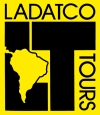

Destinations
Experiences
 |
L A
D A T C O T O U R
S |
 |
||||||||
| HOME | South America | Falkland Islands | Antarctica | Unique Destinations |
Unique Experiences |
Newsstand | ||||
ABOUT POTOSI, BOLIVIA - From Wikipedia, the Free Encylopedia:
Potosí is a city, the capital of the department of Potosí in Bolivia. It is claimed to be the highest city in the world at a nominal 4,090 m (13,420 feet). It lies beneath the Cerro de Potosí — sometimes referred to as the Cerro Rico ("rich mountain") — a mountain popularly conceived of as being "made of" silver ore, which has always dominated the city. Cerro de Potosí's peak is 4,824 meters (15,827 feet) above sea level.
Founded in 1546 as a mining town, it soon produced fabulous wealth, becoming one of the largest cities in the Americas and the world with a population exceeding 200,000 people.
In Spanish there is still a saying, valer un potosí, "to be worth a potosí" (that is, "a fortune"). For Europeans, Peru — Bolivia was part of the Viceroyalty of Perú and was known as Alto Perú before becoming independent — was a mythical land of riches. Potosí appears as an idiom for "extraordinary richness" in Miguel de Cervantes' famous novel satirizing chivalry, Don Quixote (second part, cap. LXXI). One theory holds that the mint mark of Potosí (the letters "PTSI" superimposed on one another) is the origin of the dollar sign.
It is from Potosí that most of the silver shipped through the Spanish Main came. According to official records, 45,000 tons of pure silver were mined from Cerro Rico from 1556 to 1783. Of this total, 7,000 tons went to the Spanish monarchy. Indian labour, forced by Francisco de Toledo, Count of Oropesa through the traditional Incan mita institution of contributed labor, came to die by the thousands, not simply from exposure and brutal labor, but by mercury poisoning: in the patio process the silver-ore, having been crushed to powder by hydraulic machinery, was cold-mixed with mercury and trodden to an amalgam by the native workers with their bare feet. The mercury was then driven off by heating, producing deadly vapors.
To compensate for the diminishing indigenous labor force, the colonists made a request in 1608 to the Crown in Madrid to begin allowing for the importation of 1500 to 2000 African slaves per year. An estimated total of 30,000 African slaves were taken to Potosí throughout the colonial era. African slaves were also forced to work in the Casa de la Moneda as acémilas humanas (human mules). Since mules would die after couple of months pushing the mills, the colonists replaced the four mules with twenty African slaves. (Angola Maconde 1999)
In 1672, a mint was established to coin silver and water reservoirs were built to fulfill the growing population's needs. At that time more than eighty six churches were built and the city's population increased to nearly 200,000, making it one of the largest and wealthiest cities in Latin America and in the world.
After 1800 the silver mines became depleted, making tin the main product. This eventually led to a slow economic decline. Still, the mountain continues to be mined for silver to this day. Due to poor worker conditions (lack of protective equipment from the constant inhalation of dust), the miners still have a short life expectancy with most of them contracting silicosis and dying around 40 years of age. It is estimated that, in the past years of indigenous labour, roughly 8 million Indians died, "eaten" by the Rich Hill.